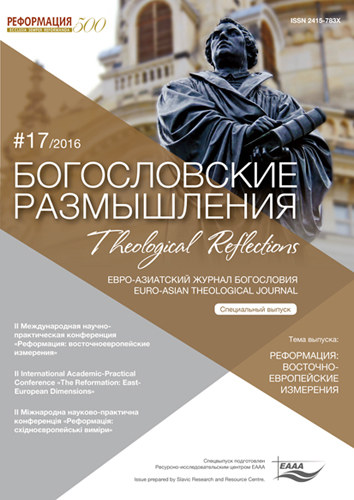Нарцис Гумiнський i Православна Євангельська Апокалiпсична Церква: забута українська Реформацiя
Keywords:
Нарцис-Ілля Гумінський, Поділля, апокаліпсисти, реформаційний рух, сектантство.Abstract
У статті вперше на документальній основі висвітлено життєвий шлях і вчення Нарциса-Іллі Гумінського (1893–1943), «пророка»-засновника Православної євангельської апокаліпсичної церкви (т. зв. «апокаліпсисти»), що дотепер існує у Вінницькій області. Ця течія, що виникла як есхатологічний рух за євангельську реформу Католицької церкви, являє собою типологічно близьку до деяких форм протестантизму версію «поміркованої» реформації. Вона зберігає розбудований богослужбовий ритуал, богородичний культ, культ ікон тощо при одночасній демократизації внутрішнього устрою церкви, наголосі на ключовому значенні Євангелія й на радикальній перебудові життя на євангельських засадах.
Ключові слова: Нарцис-Ілля Гумінський, Поділля, апокаліпсисти, реформаційний рух, сектантство.
Нарцисс-Илья Гуминский – забытый реформатор Католической церкви
В статье впервые на документальной основе освещен жизненный путь и учение Нарцисса-Ильи Гуминского (1893–1943), «пророка»-основателя Православной евангельской апокалипсической церкви (т. наз. «апокалипсисты»), до сих пор существующей в Винницкой области. Данное течение, возникшее как эсхатологическое движение за евангельскую реформу Католической церкви, представляет собой типологически близкую к лютеранству версию «умеренной» реформации. Оно сохранило развитой богослужебный ритуал, богородичный культ, культ икон и т. п. при демократизации церковного устройства, акценте на исключительном значении Евангелия и на радикальном преобразовании жизни на евангельских принципах.
Ключевые слова: Нарцисс-Илья Гуминский, Подолье, апокалипсисты, реформационное движение, сектантство.
Narcissus-Elias Guminski and a Forgotten Attempt at Catholic Church Reform in Ukraine. The article, based on previously unknown documents from the former KGB archives, discusses the life and teaching of Narcissus (Elias) Guminski (1893–1943), a Catholic monk turned prophet, who became the founder of the Orthodox Evangelical Apocalyptic Church (socalled “Apocalypsists”) still existing in Ukrainian Podolia. This religious group, which emerged in the mid-1920s as an eschatological reform movement among the Polish Roman Catholics, soon engaged large masses of Ukrainian Orthodox peasantry and evolved into a peculiar version of “moderate” Reformation which is typologically similar to Lutheranism. It combines the preservation of a well-developed liturgical ritualism, the cult of Virgin Mary and holy images etc. with a democratization of church order and a sola Scriptura approach to faith and life ethics. After initial attempts to exploit Guminski’s movement as a kind of “renovationist schism” in the Catholic Church in the USSR, the Soviet regime soon proceeded to severe repressions against the Apocalypsists that took a heavy toll on the followers of the prophet, who himself died in GULAG.
Downloads
How to Cite
Issue
Section
License
Copyright (c) 2020 Роман СКАКУН

This work is licensed under a Creative Commons Attribution-NonCommercial 4.0 International License.
All articles published in the Journal are distributed under a Creative Commons Attribution-NonCommercial 4.0 International License
By submitting an article for publication in Theological Reflections: Eastern European Journal of Theology the author grants the editors the right to publish the article and distribute it in electronic and print form.
The author reserves all copyrights and the right to use the materials of the article in whole or in part for educational purposes, to write his own dissertations, to prepare abstracts, conference reports, oral presentations, etc., as well as post electronic copies of articles (including the final electronic version downloaded from the journal’s official website) on non-commercial web-resources without the consent of the editorial board and founders.



